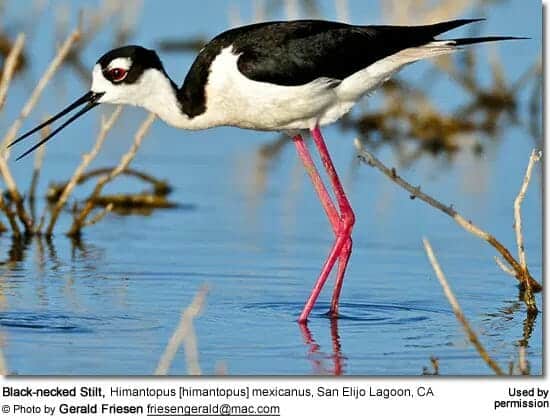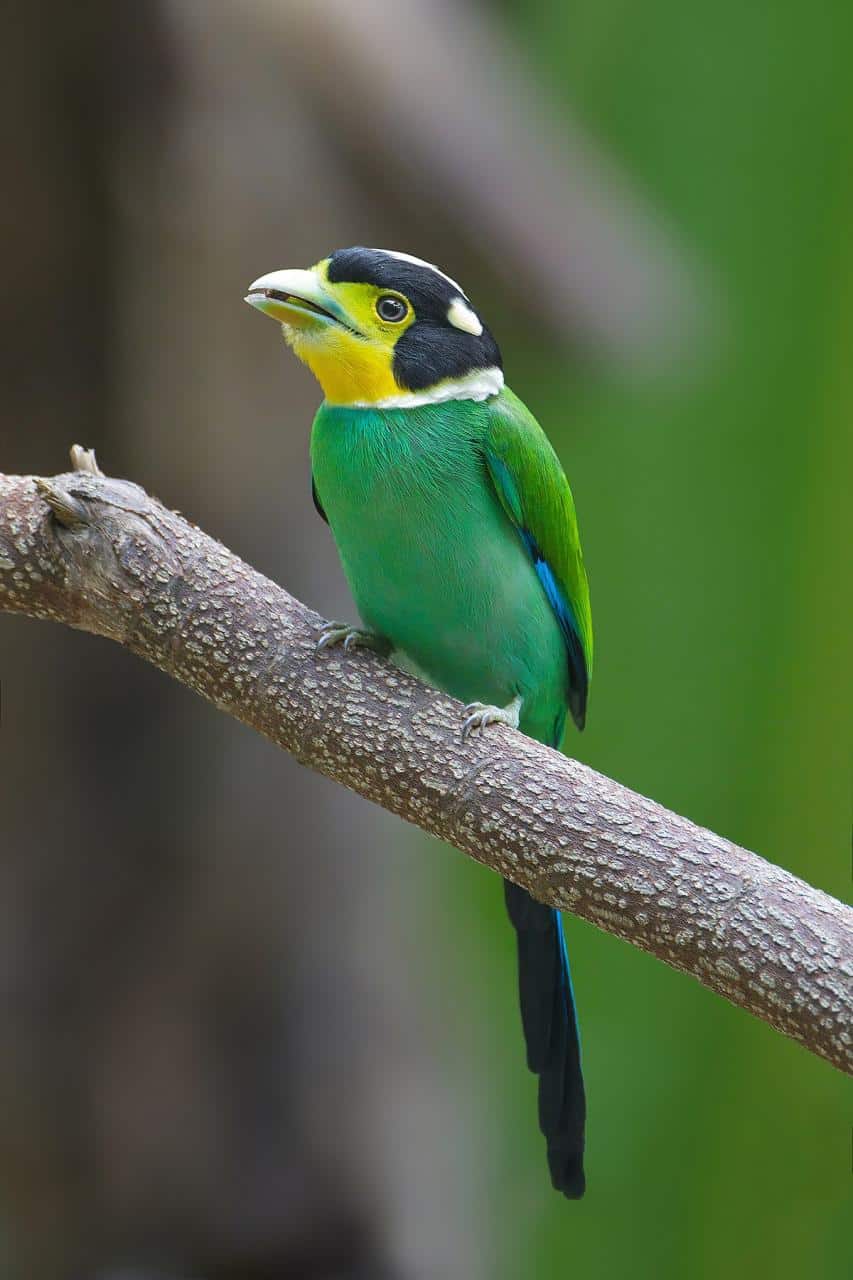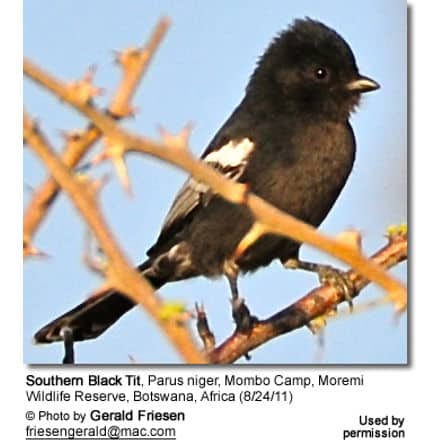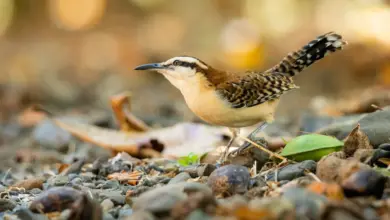Black-necked Stilts
The Black-necked Stilts (Himantopus mexicanus) are widely distributed along the Pacific coast and (to a lesser extent) along the Atlantic and the Gulf coasts of the United States. Their range extends south into Central American and parts of South America, the Caribbean and Hawaii.
These graceful waders are most easily recognized by their distinctive jet-black wings and their very long, reddish legs that make up about 60% of their total height earning them nicknames such as Longshanks or Daddy Longlegs.
Even though they can swim, they prefer to walk and feed in shallow water.
Their lifespan is about 20 years.
Distribution / Habitat / Migration Patterns
The Black-necked Stilt is locally common within its range that stretches from the coastal areas of California to wetland areas of interior western United States as far east as Idaho, Kansas, the Rocky Mountains and Arizona (around Phoenix); and along the Gulf of Mexico to Florida and south through Central America and the Caribbean to northern Brazil, southwest Peru, east Ecuador, and the Galapagos islands.

Typical Habitat
They are most commonly found in shallow wetlands, river deltas, coastlines, grassy marshes, fields, natural or artificially created lakes, drainage basins, and along the edges of shallow water in open country.
The Hawaiian subspecies inhabits wetlands, mudflats and ponds on all the major islands.
Breeding birds are usually seen in small groups. Outside the breeding season, or during the migration, these social birds form larger flocks.
Migration
Both sedentary (non-migratory) and migratory populations exist.
Those found in temperate climates are often resident, except for local movements in response to the availability of food.
Those breeding in northern regions migrate over long distances to reach their southern wintering grounds in the extreme south of the United States through Mexico to Brazil, Peru and the West Indies. Those nesting in the interior may move towards the coasts for the winter.
Southward migrations typically occur between August and September, and they return to their breeding territories between March and April. These waders generally migrate in large flocks of several hundred or even thousands.
Status
The Black-necked Stilts are legally protected under the Agreement on the Conservation of African-Eurasian Migratory Waterbirds (AEWA), which prohibits harassing, harming, pursuing, hunting, shooting, wounding, killing, trapping, capturing, or collecting listed species.
Subspecies and Ranges:
- Black-necked Stilt (Himantopus mexicanus – Statius Müller, PL, 1776) / Sometimes considered a subspecies of the Black-winged Stilt
- Range: Western and southern USA through Central America and the Caribbean to eastern Ecuador, southwestern Peru, and northeastern Brazil
- ID: White head and neck with black cap down to the eyeline. The white spot above each eye. No white band across the upper back. Black hindneck.
- Hawaiian Stilt or ae`o (Himantopus [mexicanus] knudseni – Stejneger, 1887) Sometimes considered a subspecies of the Black-winged Stilt or a full species
- Range: Found in freshwater wetlands of the Hawaiian Islands (where it is the only breeding shorebird)
- Status: Rare and endangered due to habitat destruction
- ID: More extensive black markings on the neck and head than those found in ssp. Mexicans – with the black typically extending below the eyes.
Description
Size
Height: 13 – 17 inches (~ 33 – 43 cm)
Wingspan: 27 – 28 inches (68 – 71 cm)
Weight: Between 4.8 – 7.8 oz (136 – 220 g)
Plumage Details / Adults
The upper plumage is mostly black and the plumage below is white. There is some grey banding to the otherwise grey tail.
The black cap extends to just below the eyes, with the exception of a white distinctive spot above each eye.
Breeding males have a greenish gloss to the back and wings. These areas are brown-tinged in females.
In Central Brazil, the Black-necked and White-backed Stilts are known to interbreed. Their offspring often have grey or white markings on top of the head and a grey or white collar around the neck.
Other Physical Details
- Very long reddish/pink legs with partially webbed feet
- A long, thin, black bill that curves slightly upward
- Long, pointed wings.
Juvenile Description
In immature birds, the markings that are black in adults are mostly grey. They may have some dark feathers on the white head.
Downy young are mostly light olive brown, paler below. On the wings and the back – in areas that are essentially black in adults – they have vertical rows of black speckles that are larger towards the back.
Similar Species
The American Black-necked Stilt resembles the related Black-winged Stilt (and is by some considered a subspecies). The Black-necked Stilts can be separated from vagrant Black-winged Stilts by the white spot above each eye.
Diet / Feeding
Black-winged Stilts feed on aquatic and flying insects, mollusks, tadpoles, crustaceans, spiders, oligochaete and polychaete worms, tadpoles, small fish, fish eggs and, occasionally, they will take seeds.
Foraging is mostly down in shallow waters and their long legs allow them to wade into deeper water, giving them a feeding advantage over other waders.
Insects are often taken from the water’s surface; for fish, they will plunge their heads into the water to capture them and are known to herd fish into shallow waters to trap them. Worms are pulled from the mud.
Breeding / Nesting
Breeding birds form strong, monogamous pair bonds. Both participate in constructing the nests, incubating the eggs, and raising the young. They generally breed in marshes, shallow lakes, and ponds. They usually produce only one brood in a season.
Most breeding occurs between late April through August, but regional variations are likely. They either nest solitary or in loose breeding colonies of two up to several hundred pairs with 2 up to 40 meters spacing between nests (typical is about 20 meters).
They typically build their nests on the ground near water, on small islands, or on floating vegetation. Their nests are constructed out of mud, sticks, and other material found in their environment, including shells. They are lined with soft grasses, twigs, mud chips, and pebbles. Most lining is added over time during the incubation. Some nests remain unlined. They may also nest on bare depressions on the ground.
A nest may contain 1 to 5 olive-grey, brown-speckled eggs with brown speckles. However, the average is four eggs. The parents take turns incubating the eggs for about 21 – 26 days to hatching. The hatchlings are covered with down and able to leave the nest and swim within about two hours of hatching. However, they typically remain in the nest for two days.
The female handles most of the chick care while the male’s focus is to protect the young – although he will help with brooding the eggs and feeding the young. During hot weather, the parents cool the nest with water carried to the nest under their belly feathers. They may make up to a hundred trips a day on very hot days.
These stilts feign broken wings to lure predators away from the nest. If this doesn’t work, they will aggressively dive at them, shrieking unceasingly.
At night, the young remain hidden in water to prevent predators from detecting them either by sight or by smell.
Alternate (Global) Names
Chinese: ????? … Czech: Pisila karibská … Danish: Sortnakket Stylteløber … Dutch: Amerikaanse Steltkluut … Estonian: mustpea-karkjalg … Finnish: Amerikanpitkäjalka … French: Échasse américaine, Échasse d’Amérique, Échasse d’Amérique ou É. des Hawaï … German: Nordamerikanischer Schwarznacken-Stelzenläufer, Schwarznacken-Stelzenläufer … Guadeloupean Creole French: Gibier la mort … Guarani: Tetéu jagua … Italian: Cavaliere collonero, Cavaliere nordamericano … Japanese: kuroeriseitakashigi … Lithuanian: Amerikinis k?jokas … Norwegian: Svartkronestylteløper … Polish: szczudlak bialobrewy, szczud?ak bia?obrewy … Portuguese: Pernilongo, pernilongo-de-costas-brancas, pernilongo-de-costas-negras … Russian: ???????????? ?????????? … Slovak: Éišila ?iernokrká, šišila ?iernokrká … Spanish: Candelero Americano, Cigüeñuela Americana, Cigüeñuela Cuellinegra, Cigüeñuela Cuellinegro, Cigüeñuela de Cuello Negro, Perrito, Soldadito, Tero real, Viuda, Zancudo … Swedish: Amerikansk styltlöpare




